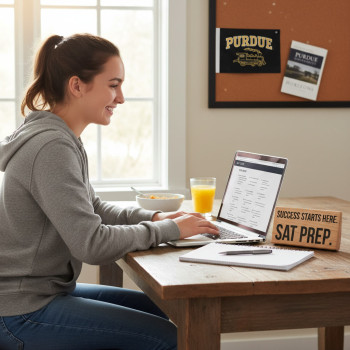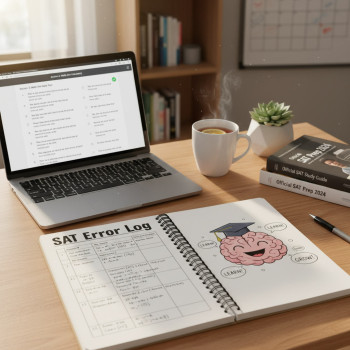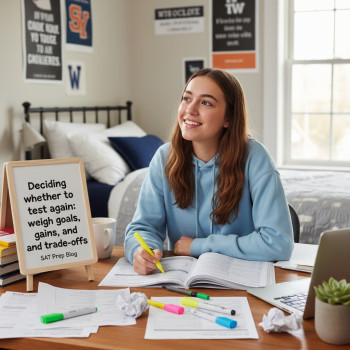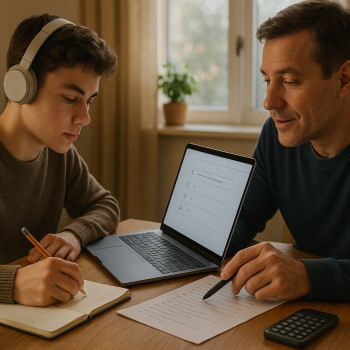The quiet truth about practice: why full-length digital SAT tests matter
Imagine walking into test day as if you’ve already been there a dozen times. The lights, the digital interface, the little hum of concentration in the room — nothing feels unfamiliar. That’s what a full-length digital SAT practice test does for you: it turns anxiety into routine and uncertainty into a repeatable process.
Short drills and question sets are useful. But if you want to transform progress into performance, nothing replaces a full-length practice test taken under realistic conditions. It’s not only about content knowledge; it’s about pacing, endurance, strategy, and the tiny psychological habits that add up to big score improvements.
What we mean by a “full-length” digital practice test
A full-length digital SAT practice test mirrors the real exam in length, section order, and timing. For the modern SAT delivered digitally, that means taking the test in the Bluebook environment (or other official practice simulators) and experiencing the exact interface, tools, and section structure you’ll face on test day. That includes adaptive sections, on-screen highlighting, calculators where allowed, and timed breaks between sections where applicable.
Top reasons to prioritize full-length digital practice tests
Here are the core benefits you start to feel after just a couple of realistic practice runs:
- Test-day familiarity: You learn the look and feel of the app so nothing surprises you.
- Pacing mastery: Real sections force you to practice managing time across dozens of questions, not just one or two.
- Stamina building: The SAT is as much a mental marathon as it is an assessment of academic skills.
- Strategic practice: Full tests reveal which strategies work under pressure (e.g., question triage, calculator timing).
- Accurate score feedback: Official practice platforms score full tests the same way the real test does, giving you trustworthy progress data.
- Actionable diagnostics: When paired with a study plan, test results translate directly into targeted review and more efficient study time.
A word on simulation vs. familiarity
Taking a test in bits and pieces is practice; taking an entire test end-to-end is rehearsal. Familiarity reduces friction; simulation trains habits. When you close your laptop after a full-length run, you haven’t just answered questions—you’ve rehearsed test-day behavior.
How full-length practice tests sharpen the skills that matter most
Let’s break down exactly what improves when you prioritize full-length practice:
Pacing and time awareness
The most common reason students leave points on the table is poor time management. Full-length practice teaches two complementary skills: (1) macro pacing — how much time to give each section overall; (2) micro pacing — how long to linger on a single question before moving on. Repeated runs help you internalize these rhythms so decisions feel automatic on test day.
Endurance and mental focus
Mental fatigue is real. You might be lightning-fast on a set of twenty practice questions at 7:00 p.m., but can you stay sharp for the entire duration of the test? Full-length practice builds the mental muscles that keep concentration steady through the last section.
Adaptive behavior and strategy
The digital SAT features adaptive elements. Full-length tests let you experience those dynamics — when a section nudges you into easier or harder material based on your earlier performance. That experience teaches you how to prioritize accuracy versus speed and when to use question-level strategies that preserve opportunities later in the test.
Realistic test anxiety exposure
Anxiety is less of an enemy and more of a signal. Full-length practice exposes you to stress in a controlled setting so you can learn calming rituals (breathing, micro-breaks, reset routines) and test how well they work. Once practiced, these rituals become automatic on test day.
How to make each full-length practice test count (a step-by-step plan)
If you’re going to commit several hours to a practice run, get the most value from it. Treat each practice test like a mini-experiment:
- Before the test: Create test-day conditions. Choose a quiet room, use the same device type you’ll bring on test day (if possible), and set up a timer. Gather permitted tools and simulate any accommodations you have approved.
- During the test: Stick to your strategy: triage early, flag questions to revisit, and manage calculator use. Practice the exact timing patterns you plan to use on test day.
- After the test: Score it, then sit with your mistakes. Spend as much time analyzing the test as you spent taking it—that’s where the learning happens.
Use this review checklist after every full-length test
- Identify the easiest and hardest question types you missed.
- Track whether mistakes were careless or content-based.
- Record where you ran out of time or felt rushed.
- Create a short practice set (10–20 questions) that targets your weakest area for the next study block.
- Compare scores across tests and detect trends, not single-test noise.
Sample study calendar: how to integrate full-length tests into your prep
Here’s a simple, realistic calendar for a two-month prep plan where you take three full-length tests. Adjust to fit your starting point and goals.
| Week | Focus | Full-Length Test |
|---|---|---|
| Week 1 | Diagnostic test, identify weaknesses | Take Test 1 (diagnostic) |
| Weeks 2-3 | Targeted skill work (math fundamentals, reading strategies) | No full-length tests; short drills and review |
| Week 4 | Simulate test-day pacing and endurance | Take Test 2 (timed, under realistic conditions) |
| Weeks 5-6 | Polish weak areas; refine timing strategies | Targeted practice and small mixed sets |
| Week 7 | Full dress rehearsal; mental strategies | Take Test 3 (two weeks before test day) |
| Week 8 | Light review, confidence building, rest | No full-length tests; light practice only |
This schedule balances measurement and targeted practice. The diagnostic identifies the baseline; mid-prep test measures growth; final test validates readiness.
Quantifying improvements: what data to collect
A practice test is a treasure trove of metrics beyond just a raw score. Track these consistently and trends will reveal where you should spend time:
- Section scores (Reading & Writing, Math)
- Percent correct by question type (e.g., command of evidence, algebra, data analysis)
- Time per question, averaged by section
- Number of flagged/skipped questions
- Proportion of careless vs. conceptual mistakes
Example: how marginal gains add up
Imagine you shave just 10 seconds off your average time per math question while maintaining accuracy. Across 40 math questions that’s 400 seconds (over 6 minutes) reclaimed — often enough to revisit 3–5 flagged questions and convert a few guesses into correct answers. Small pacing tweaks compound into meaningful score increases.
Common mistakes students make with full-length tests (and how to avoid them)
Students take tests but then stop at the score. The real gift is in the post-test work. Here are frequent missteps and quick fixes:
- Mistake: Treating practice like a one-off performance.
Fix: Treat each test as diagnostic data. Plan specific drills informed by your results. - Mistake: Overdoing full-length tests too close together.
Fix: Space tests out so you have time for targeted practice between them. - Mistake: Ignoring test environment.
Fix: Simulate the exact device and setting you’ll use on test day whenever possible. - Mistake: Focusing only on content.
Fix: Practice test-taking strategies: flagging, skipping, and time audits.
How to combine official practice with personalized support
Official full-length tests give you the most realistic measure of progress, but the interpretation of results is where targeted improvement lives. That’s where personalized tutoring can be transformative. When a tutor reads your test data, they can design laser-focused sessions to close gaps quickly: conceptual weak points, recurring careless mistake patterns, or pacing adjustments tailored to your problem areas.
Sparkl’s personalized tutoring model, for example, blends 1-on-1 guidance, tailored study plans, expert tutors, and AI-driven insights to accelerate what you learn from each practice test. You get a study plan that translates test metrics into concrete practice steps, a tutor who models strategies during live runs, and AI-backed analytics that spot trends a human might miss. When used alongside official full-length practice tests, this combination turns test runs into reliable score progress.
How a tutor can help after a full-length test
- Reviewing missed questions one-by-one to identify misconception patterns.
- Designing short, focused practice sets that directly attack weak areas.
- Teaching pacing drills and real-time correction strategies during simulated sections.
- Building mental routines for test-day stress management and confidence.
What to expect from official digital practice resources
The organizations that produce the SAT provide full-length digital practice tests that mirror the official experience. Expect to find:
- Timed, scored practice in the same testing environment as the real SAT.
- Performance analytics and a student question bank to drill specific skills.
- Options to practice with certain built-in accommodations for familiarity (note: practicing with built-in tools does not equal approval for accommodations on test day).
Practical tips for the week before test day
The final week is about consolidating strengths, not learning new content. Here’s a short checklist to follow:
- Take one final full-length test two weeks before the exam to confirm readiness; then taper.
- In the last seven days, replace heavy study with short, focused review sessions and light mixed practice sets.
- Practice the logistics: device charged, Bluebook installed and updated, permitted calculator ready.
- Do a short simulated session (30-60 minutes) two days before to keep timing fresh without burning out.
- Sleep, hydrate, and maintain a steady routine. Your cognitive performance depends on rest more than cramming in the last days.
Measuring success: when are you “ready”?
Readiness is more than a number. While score targets matter, readiness is a composite of metrics:
- Consistent full-length scores within a target range across multiple tests.
- Improved accuracy on previously weak question types.
- Reliable pacing: you finish sections with time to spare for review.
- Lower test-day anxiety and a practiced set of calming routines.
When these elements align, a single test-day fluctuation matters less — because you’ve built a process that reliably produces your best effort.
Final thoughts: make practice tests part of your study identity
Full-length digital SAT practice tests are more than checkpoints; they’re the engine of improvement. They create a loop: simulate, measure, analyze, practice, and simulate again. Each cycle makes your strategies crisper and your confidence deeper. The magic isn’t in taking a lot of tests; it’s in taking smarter tests and learning more from each one.
If you combine official full-length practice tests with a clear review routine and occasional personalized coaching — whether it’s a tutor who helps you interpret data or a platform that personalizes practice based on your results — you transform scattered effort into predictable, measurable growth. And if you want that human layer of tailored feedback, Sparkl’s personalized tutoring programs can be an efficient and focused way to turn test runs into real score gains through 1-on-1 guidance, tailored study plans, expert tutors, and AI-driven insights.
Quick takeaway checklist
- Take at least two to three full-length digital practice tests during a typical prep cycle.
- Simulate real test-day conditions: device, timing, and environment.
- Spend as much time reviewing a test as you spent taking it.
- Use the test data to guide short, targeted practice sets between full tests.
- Consider occasional personalized tutoring to accelerate improvement and interpret analytics efficiently.
Practice smart. Practice full-length. Turn test day from a guessing game into a familiar stage where you know your lines, your timing, and how to deliver your best performance.
Ready to get started?
Open your testing app, schedule your first full-length run, and treat it like a rehearsal worth every minute. With smart review and focused practice, your next test will feel less like a test and more like the confident result of well-practiced habits.
















No Comments
Leave a comment Cancel